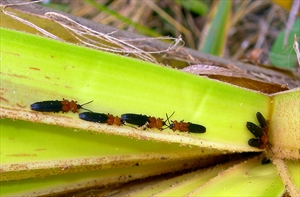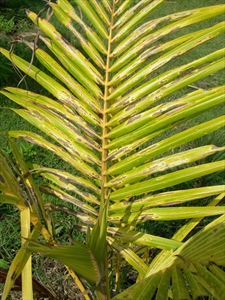Coconut hispine beetle, coconut leaf hispa.
Pacific Pests, Pathogens, Weeds & Pesticides - Online edition
Pacific Pests, Pathogens, Weeds & Pesticides
Coconut hispine beetle (059)
Brontispa longissima
Asia, Southeast Asia, Oceania. It is recorded from American Samoa, Australia, French Polynesia, New Caledonia, Papua New Guinea, Samoa, Solomon Islands, Vanuatu, and Wallis & Futuna. Note, another species, the Pohnpei coconut leaf beetle, Brontispa chalybeipennis, in recorded from Marshall Islands; Brontispa mariana from the Federated States of Micronesia and Northern Mariana Islands; and Brontispa palauensis from Guam and Palau.
Coconuts are the most important crop attacked, but the beetles also infest betel nut, sago palm, oil palm, and a number of ornamental and wild palms.
Palms of all ages are attacked, but the damage done to seedlings in nurseries and young palms after planting out is often severe. The adults (Photo 1) and larvae graze the leaflets of the unopened spear leaf, forming narrow red-brown streaks parallel to the midrib. As the leaf unfolds, these streaks enlarge, forming irregular greyish blotches (Photo 2); when severe, this gives the palm a scorched appearance (Photo 3).
The entire life cycle of the beetles takes place in the unopened spear leaf. Eggs are laid in grooves chewed into the leaflets and covered by excreta. The eggs hatch after 4-5 days, and the larvae pass through several moults during the next 4 weeks before they pupate. Six days' later the adults emerge. They are 8-10 mm long and 2 mm wide, and live for about 7 months. The females lay 100 eggs or more.
Severe attacks may kill the palm, and those that survive are more susceptible to drought and disease. Yield of bearing palms is reduced considerably. There is, however, a large difference between the susceptibility of varieties with Malayan Dwarf very susceptible. Betel nuts, too, are badly damage by the hispine beetle, especially when the palms are young.
Look for the narrow brown streaks on the leaflets, and red and black beetles between them. Look for fronds with ragged leaflets, with those still green bearing large dry dead blotches parallel to the length of the leaflets.
NATURAL ENEMIES
Brontispa is mostly under control by its natural enemies. Tetrastichus brontispae, a wasp, was introduced successfully into the Russell Islands, Solomon Islands, in the 1930s and again in the 1960s, making spraying of young palms unnecessary. The same wasp was introduced into Samoa in the 1980s from New Caledonia, and was responsible for the initial decline of Brontispa at that time. Later, another wasp, Chrysonotomyia sp., was found attacking the larvae, which may be a native species. Both Tetrastichus and Chrysonotomyia attack Brontispa larvae.
In recent years, serious outbreaks in Asia have been brought under control by introducing Asecodes hispinarum, also a larval parasitoid.
Earwigs (Chelisoches morio) are reported to feed on the larvae of Brontispa, and the fungus, Metarhizium anisopliae, also causes high mortality.
RESISTANT VARIETIES
In Solomon Islands, there is evidence that the Local Tall and Rennell varieties are more resistant than Federated Malay States and Malayan Red (or Yellow) Dwarf. The hybrid between Rennell Tall and Malayan Dwarf is susceptible. Some varieties from Ivory Coast and Fiji were resistance when tested in Solomon Islands, as was a green dwarf in Samoa.
CHEMICAL CONTROL
Occasionally, insecticides are needed in the nursery and on young palms after planting out, especially where susceptible varieties of coconuts are planted in areas that have dry seasons, e.g., the Guadalcanal Plains, Solomon Islands.
- Use plant-derived products, such as derris, pyrethrum or chilli (with the addition of soap). (See Fact Sheet no. 56).
- Alternatively, synthetic pyrethroids are likely to be effective, but will also kill natural enemies.
--------------------
Note,
derris (Derris species) contains rotenone, an insecticide, often used as a fish poison; it should be used with caution. The commercial derris insecticide is made from Derris elliptica.
____________________
When using a pesticide, always wear protective clothing and follow the instructions on the product label, such as dosage, timing of application, and pre-harvest interval. Recommendations will vary with the crop and system of cultivation. Expert advice on the most appropriate pesticides to use should always be sought from local agricultural authorities.
AUTHORS Helen Tsatsia & Grahame Jackson
Information from Waterhouse DF, Norris KR (1987) Brontispa longissima (Gestro). Biological Control Pacific Prospects. Inkata Press; and from Brumley C (2008) coconut hispine beetle (Brontispa longissima): PaDIL - (http://www.padil.gov.au).
Produced with support from the Australian Centre for International Agricultural Research under project PC/2010/090: Strengthening integrated crop management research in the Pacific Islands in support of sustainable intensification of high-value crop production, implemented by the University of Queensland and the Secretariat of the Pacific Community.






